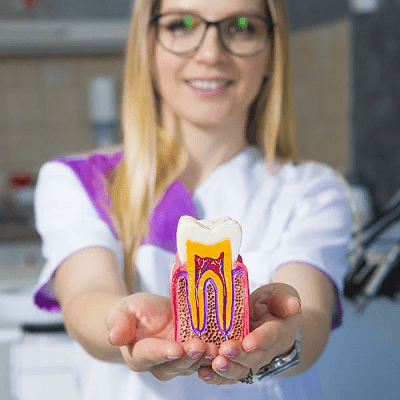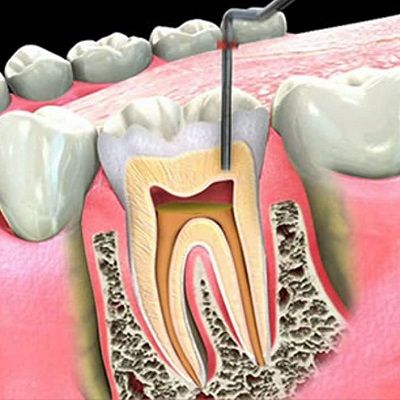
Your teeth are a crucial component of your mouth and help with a variety of oral functions. The vast majority of people neglect oral hygiene, which leads to tooth deterioration. They fail to clean their teeth, which encourages plaque buildup on your teeth. Even using force when cleaning your teeth won’t completely eradicate this plaque. There is a presence of the pulp inside the tooth. It is actually an accumulation of connective tissue that is present just below the dentin layer. This is the reason it is called endodontic. When the bacteria attach to the pulp, it becomes inflamed and infected. This causes pain and infection in the tooth. The root canal treatment helps the pulp to get removed and relieves the pain and infection. It has grown in popularity recently and produces extremely good outcomes. But people always doubt about Is Root Canal Treatment Painful.
What is it?
Root Canal Treatment in Dubai & Abu Dhabi is a dental procedure that helps to treat infectious tooth pulp. The pulp is the soft tissue that surrounds the root of the tooth and contains blood arteries, nerves, and connective tissue.
The doctor removes the damaged or diseased pulp during root canal therapy. If a tooth needs to be removed, root canal therapy may be a viable alternative. It can reduce discomfort, enhance dental health, and bring back the afflicted tooth’s functionality.
Why Have a Root Canal Right Away?
If the dentist advises you to have a root canal treatment it is important to get it right away. There are some reasons why your doctor suggests root canal treatment at an accurate time. Because postponing treatment can result in additional issues, more involved dental work, and higher costs.
- If a tooth’s pulp becomes infected or injured, it won’t heal on its own and the infection may spread to the bone and tissues around. Ultimately, it will lead to discomfort, swelling, and perhaps even more serious health issues.
- Delaying treatment can also weaken the tooth and make it more prone to fracture or other injury, which can complicate the healing process.
- A broken tooth provides an opening that makes it easier for germs to enter. It allows harmful pathogenic germs entrance, which damages the inner gums and teeth.
- Gum pus has the potential to enter the jaws as well. Due to this, the jaws start swelling which raises the possibility of infection. Your food may taste different if your jaw is inflamed, and you may also have foul breath.
Procedure:
The doctor first examines the past medical history thoroughly. He does this because hypertension and diabetes can interfere with the treatment. Moreover, bleeding disorders may also cause some consequences. Therefore, to avoid any risks the doctor evaluates medical as well as drug history so that the treatment goes well. The doctor performs this treatment under his supervision in his clinic.
- The doctor uses local anesthesia to numb the region around the injured tooth.
- To get access to the pulp chamber, he makes a small hole at the top of the tooth.
- Removes the pulp that has been harmed or diseased using tiny tools called files.
- Cleanses and shapes the root canal in order to get it ready for filling,
- Uses Gutta-percha, a substance resembling rubber, to seal the root canal and stop future infection.
- To keep the tooth safe until a permanent restoration can be applied, a temporary filling is put in.
- Takes out the temporary filling and protects and functionally repairs the tooth with a filling or crown during a subsequent session.
- The doctor examines the tooth after the procedure completes.
Is Root Canal Treatment Painful?
The doctor uses local anesthesia, which numbs the region and makes the process comfortable for the patient during root canal therapy. Although some discomfort or sensitivity in the treated tooth and the surrounding area is common for patients to experience after the procedure. This is typically manageable with over-the-counter pain medications, and it usually goes away within a few days.
It is important to remember that the goal of root canal therapy is to get rid of discomfort and make a damaged or infected tooth functional again. Even though the procedure itself might be uncomfortable. But the long-term advantages of preserving the tooth and avoiding further infection or complications usually outweigh any short-term discomfort.
AfterCare:
This procedure has no side effects and is non-invasive. However, this therapy helps to get rid of the bacterial infection. In order to prevent infection recurrence, patients must be extremely attentive when following the aftercare instructions.
- Follow the directions on any prescription painkillers.
- Till the final restoration is in place, avoid biting or chewing on the treated tooth.
- By frequently brushing and flossing, maintain proper dental hygiene.
- Avoid meals that are hard or sticky as they may harm the temporary filling or repair.
- Attend all planned follow-up visits.
- Contact your dentist or endodontist right away if you experience excruciating pain, swelling, or other symptoms.
Benefits:
The benefits of the procedure are considerable because it helps to relieve the pain and discomfort caused by an infected tooth.
- Stops an infection from spreading to nearby gums and jaws.
- Cleans the infected pulp instead of extracting the tooth.
- Decreases inflammation and discomfort.
- The infected pulp might lead to bone loss and ruin the tooth’s bone. This root canal treatment keeps it safe.
Book A Consultation!
Is Root Canal Treatment Painful? Get your answer now by consulting our doctors. Fill out the consultation form mentioned below to book your appointment with well-qualified doctors in Dynamic clinic in Dubai.


































